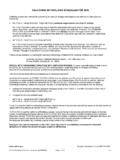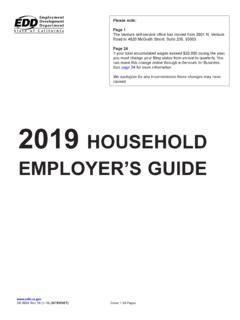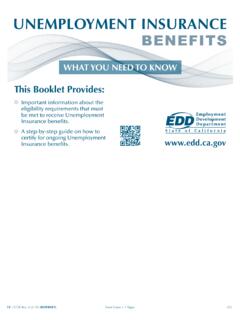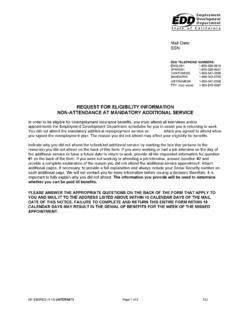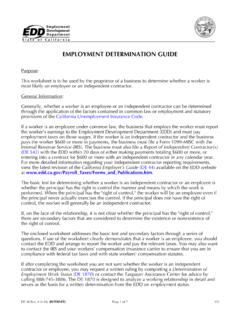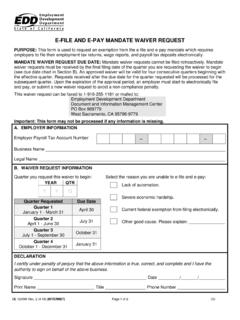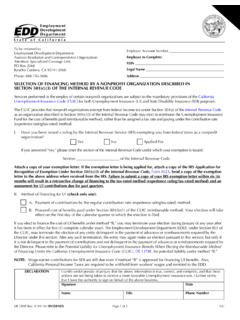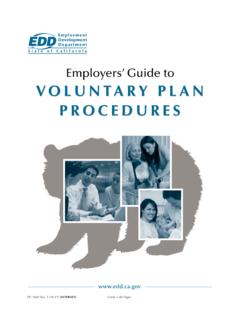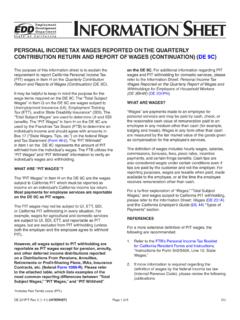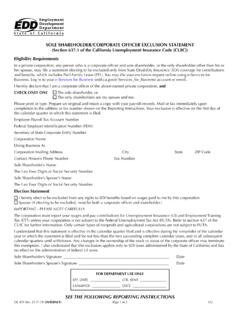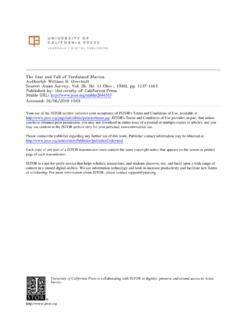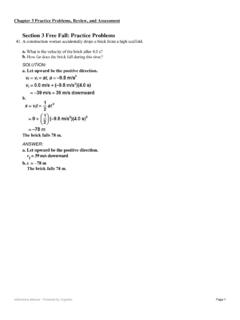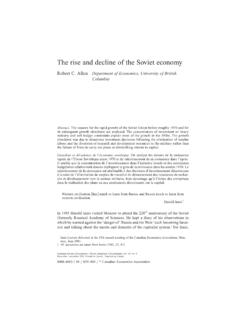Transcription of CALIFORNIA SYSTEM OF EXPERIENCE RATING
1 CALIFORNIA SYSTEM OF EXPERIENCE RATING New employers are assigned a percent Unemployment Insurance (UI) rate for a period of two to three years. This will depend on when the employer meets the criteria under Section 982(b) of the CALIFORNIA Unemployment Insurance Code (CUIC). This is referred to as the employer s UI contribution rate. After that, an employer s UI contribution rate is determined by his/her EXPERIENCE RATING and the condition of the UI Fund. Public school districts and some other eligible organizations can elect to pay for UI benefts through a reimbursable method. For additional information, refer to the UI Taxes section of the CALIFORNIA Employer s Guide, DE 44. UI RESERVE ACCOUNT An employer is assigned an employer payroll tax account number when registering with the Employment Development Department (EDD) for the frst time.
2 Once the employer becomes subject to the provisions of the CUIC, a reserve account with no balance is created. The reserve account is a cumulative record of credits (+) and charges (-) and is the basis for the EXPERIENCE RATING method. It is used to determine the employer s annual UI contribution rate. The difference between the credits and charges is the reserve account balance. It may be positive or negative and is non-refundable. Each year, the reserve account balance is determined based on the EDD records as of July 31. The following method is used to calculate the reserve account balance: Previous reserve account balance + Credits to reserve account Charges to reserve accountNew reserve account balance HOW YOUR UI CONTRIBUTION RATE IS ESTABLISHED The method of determining contribution rates is called EXPERIENCE RATING .
3 This method uses a formula to measure the stability of the employer s employment and the potential for future unemployment. Employers contribution rates are based on one of seven contribution rate schedules established by the CUIC. See the UI Tax Rate Schedule at the end of this information sheet showing the reserve ratios and the seven contribution rate schedules. The frst step in the annual process of establishing UI contribution rates is to determine which of the seven contribution rate schedules is in effect for the calendar year, using the following formula: Balance of the UI Fund on September 30 Gross wages reported by all employers during the fscal year ending on the computation date (June 30) = Percentage to determine the rate schedule This calculation establishes the rate schedule as follows: PERCENTAGECONTRIBUTION RATE SCHEDULES Greater than: Equal to or less AA A B C D (or equal to) E (or equal to) F NOTE.
4 If the calculation produces a ratio less than percent, an emergency solvency surcharge rate of times the rates on Schedule F is in effect. The second step in establishing UI contribution rates is to compute your reserve ratio. Your ratio is determined by the ratio of your reserve account balance on July 31 to your average base payroll, using the following formula: Your reserve account balance Your average base payroll = Your Ratio Your reserve ratio is then compared to the applicable rate schedule in effect for the coming year. NOTE: Your average base payroll is the average of your taxable payrolls for three calendar years immediately preceding the computation date, June 30. EXCEPTIONS: If you have taxable payroll in only two calendar years immediately preceding the computation date, the average base payroll is based only on the wages for those two years.
5 If you have taxable payroll in only one calendar year immediately preceding the computation date, the average base payroll is based on the wages for that one year. DE 231Z Rev. 16 (8-16) (INTERNET) Page 1 of 7 CU CONTRIBUTION RATE NOTIFICATION You will be notifed of your UI, Employment Training Tax (ETT), and State Disability Insurance (SDI) rates on a Notice of Contribution rates and Statement of UI Reserve Account, DE 2088. The DE 2088 is issued during the month of December. Any item on the DE 2088 may be protested except the ETT and SDI rates . Complete instructions for fling a protest are included on the Explanation of the Notice of Contribution rates and Statement of UI Reserve Account, DE 2088C. The DE 2088 contains the following information: The assigned contribution rates for UI, ETT, and SDI.
6 The annual taxable wage limit for UI, ETT, and SDI. The UI tax rate schedule in effect for the calendar year. The factors used in computing the UI reserve account ratio. ETT FUND The ETT is a separate and additional tax of percent of the UI taxable payroll on positive reserve account employers only. The purpose of the ETT is to provide a controlled funding source for training. The ETT is due and payable quarterly. The following employers do not contribute to the ETT Fund: Employers who have a negative reserve account balance on June 30, except if subject to Section Subdivision (b) of the CUIC. Employers who have elected a reimbursable method of fnancing UI benefts. SDI FUND The SDI is a wage continuation plan for employees who are unable to work because of non-occupational illness or injury.
7 It is funded through employee payroll deductions. The SDI withholding rate is the same for all employees and is calculated pursuant to Section 984 of the CUIC. It is an annual rate that may increase, decrease, or remain the same, depending on the balance in the SDI Fund on September 30 and the amount of disbursement, and wages paid. CREDITS TO YOUR UI RESERVE ACCOUNT Your UI reserve account is credited with the following: The UI contributions paid from August 1 through July 31. This may include adjustments and Voluntary UI (VUI) payments. However, payments made in July for the quarter ending September 30 will not be included. The amount of interest credited is computed as follows: Your preliminary Balance Your reserve account balance x of interest = individual Total of all positive earned credits reserve account balances The amount canceled from your UI reserve account per Section of the CUIC.
8 This occurs when your UI reserve account balance is negative and is more than 21 percent of your average taxable payroll during the last three calendar years. A prorated share of the following: -The total money collected from the claimants who were overpaid UI benefts in error or because of fraud. -The total of all the positive reserve accounts canceled after three years as inactive. -The miscellaneous income items to the UI Fund that are not included above. CHARGES TO YOUR UI RESERVE ACCOUNT Your UI reserve account is charged for the following: Benefts paid to your former employees from July 1 through June 30, which may include additional benefts for training or retraining of skills. A prorated share of the following: -The total annual increase of all negative reserve account balances.
9 -The total UI benefts paid in error or because of fraud that were identifed during the fscal year ending June 30. -The total UI benefts paid that were not charged to individual reserve accounts. -The miscellaneous expense items applied to the UI fund that are not included above. DE 231Z Rev. 16 (8-16) (INTERNET) Page 2 of 7 SHARED CREDITS AND CHARGES The amount of all shared credits and all shared charges are computed by dividing: Your UI taxable wages for the fscal year ending June 30 = Percentage applied Total of all employers UI to the shared items taxable wages for fscal year ending June 30 MINIMIZE YOUR UI CONTRIBUTION RATE An employer who maintains a stable workforce, while fling and paying taxes on time, generally has a lower UI rate.
10 An employer who experiences high turnovers, large fuctuations in payroll, and/or fles and pays taxes late will have a higher rate. The following suggestions may help you to minimize your UI contribution rate: Work with your employees to avoid layoffs and voluntary quits. Every separation has a potential to increase your UI contribution rate. Grant leaves of absence to employees to help you keep fully trained personnel. Give written warning notices prior to discharging an employee. Keep a copy of these written notices and any supporting information for use in justifying the actions taken. Conduct exit interviews with employees to understand why an employee is leaving. This may result in changes to your company policies or procedures and may assist you in retaining your trained employees.
